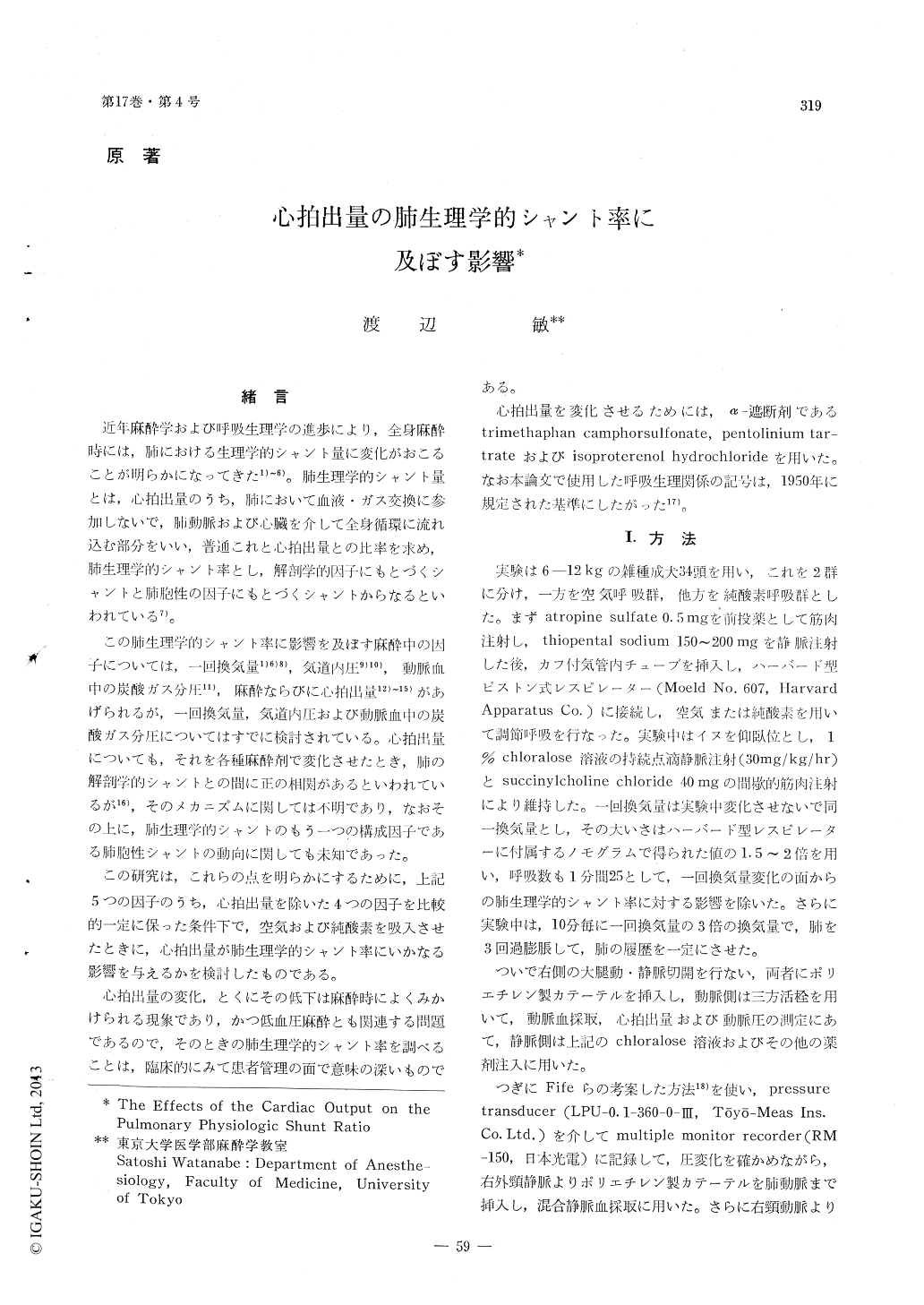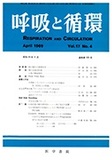Japanese
English
- 有料閲覧
- Abstract 文献概要
- 1ページ目 Look Inside
緒言
近年麻酔学および呼吸生理学の進歩により,全身麻酔時には,肺における生理学的シャント量に変化がおこることが明らかになってきた1)〜6)。肺生理学的シャント量とは,心拍出量のうち,肺において血液・ガス交換に参加しないで,肺動脈および心臓を介して全身循環に流れ込む部分をいい,普通これと心拍出量との比率を求あ,肺生理学的シャント率とし,解剖学的因子にもとづくシャントと肺胞性の因子にもとづくシャントからなるといわれている7)。
この肺生理学的シャント率に影響を及ぼす麻酔中の因子については,一回換気量1)6)8),気道内圧9)10),動脈血中の炭酸ガス分圧11),麻酔ならびに心拍出量12)〜15)があげられるが,一回換気量,気道内圧および動脈血中の炭酸ガス分圧についてはすでに検討されている。心拍出量についても,それを各種麻酔剤で変化させたとき,肺の解剖学的シャントとの間に正の相関があるといわれているが16),そのメカニズムに関しては不明であり,なおその上に,肺生理学的シャントのもう一つの構成因子である肺胞性シャントの動向に関しても未知であった。
この研究は,これらの点を明らかにするために,上記5つの因子のうち,心拍出量を除いた4つの因子を比較的一定に保った条件下で,空気および純酸素を吸入させたときに,心拍出量が肺生理学的シャント率にいかなる影響を与えるかを検討したものである。
心拍出量の変化,とくにその低下は麻酔時によくみかけられる現象であり,かつ低血圧麻酔とも関連する問題であるので,そのときの肺生理学的シャント率を調べることは,臨床的にみて患者管理の面で意味の深いものである。
心拍出量を変化させるためには,α—遮断剤であるtrimethaphan camphorsulfonate, pentolinium tar—trateおよびisoproterenol hydrochlorideを用いた。なお本論文で使用した呼吸生理関係の記号は,1950年に規定された基準にしたがった17)。
Changes of pulmonary physiologic shunt ratio were measured in dogs under light anesthesia with chloralose at two levels of alveolar oxygen tension obtained by breath-ing air and pure oxygen, when cardiac out-put was artificially changed by use of trimethaphan camphorsulfonate, pentolinium tartrate and isoproterenol hydrochloride. Dur-ing this experiment constant ventilation was maintained by Harvard respirator.
Pulmonary physiologic shunt ratio was calculated from the shunt equation. Oxygen content of blood was measured by using oxygen tension, hemoglobin concentration and oxygen saturation of blood. Oxygen tension of pulmonary capillary blood wasestimated by the alveolar air equation. Mixed venous blood was taken through a cardiac catheter. Cardiac output was measured by the dye-dilution method.
Pulmonary physiologic shunt ratio and oxygen content of mixed venous blood dec-reased in direct proportion to cardiac output. This findings was observed when breathing both air and pure oxygen. The change of pulmonary physiologic shunt ratio was more remarkable when breathing air than pure oxygen. Oxygen tension and carbon dioxide tension of blood, intratracheal pressure and alveolar-arterial oxygen tension difference did not change during this procedures.
These findings had no relation to different types of drugs during this experiment.

Copyright © 1969, Igaku-Shoin Ltd. All rights reserved.


